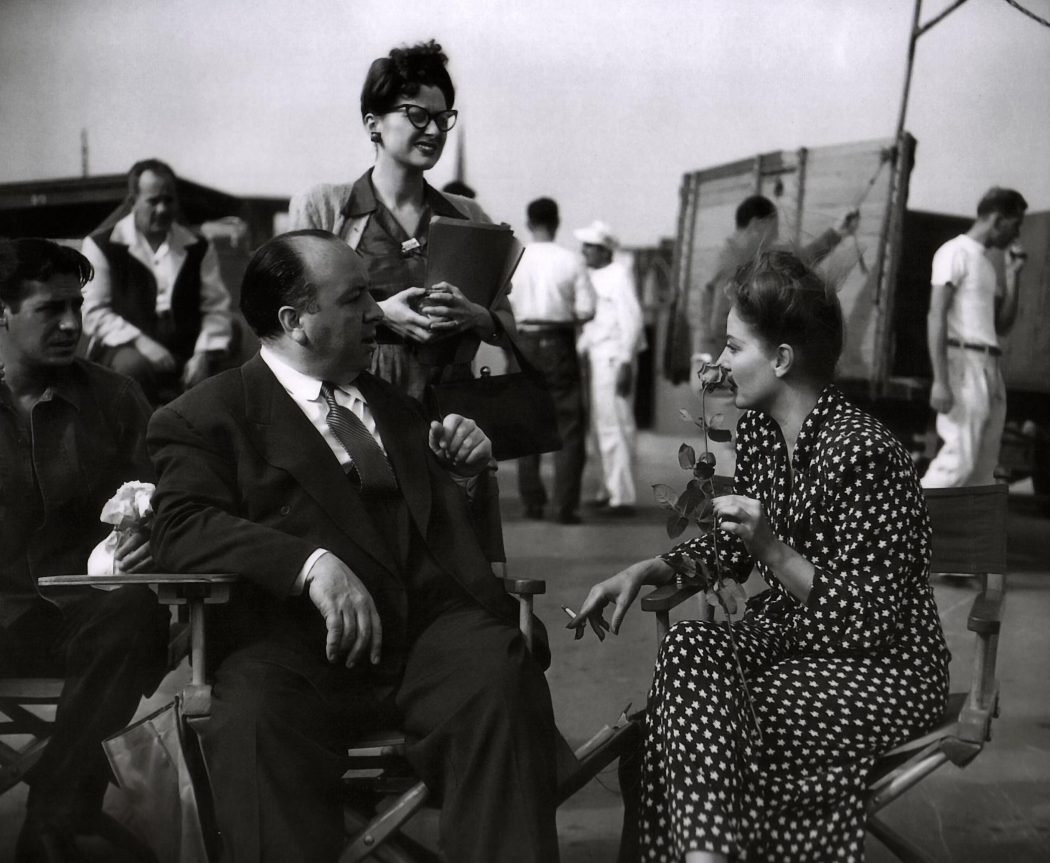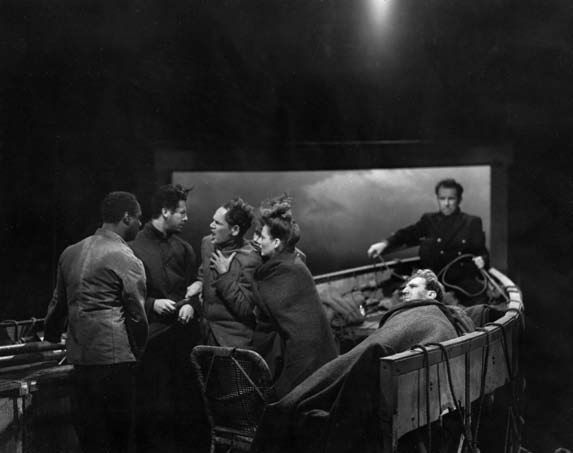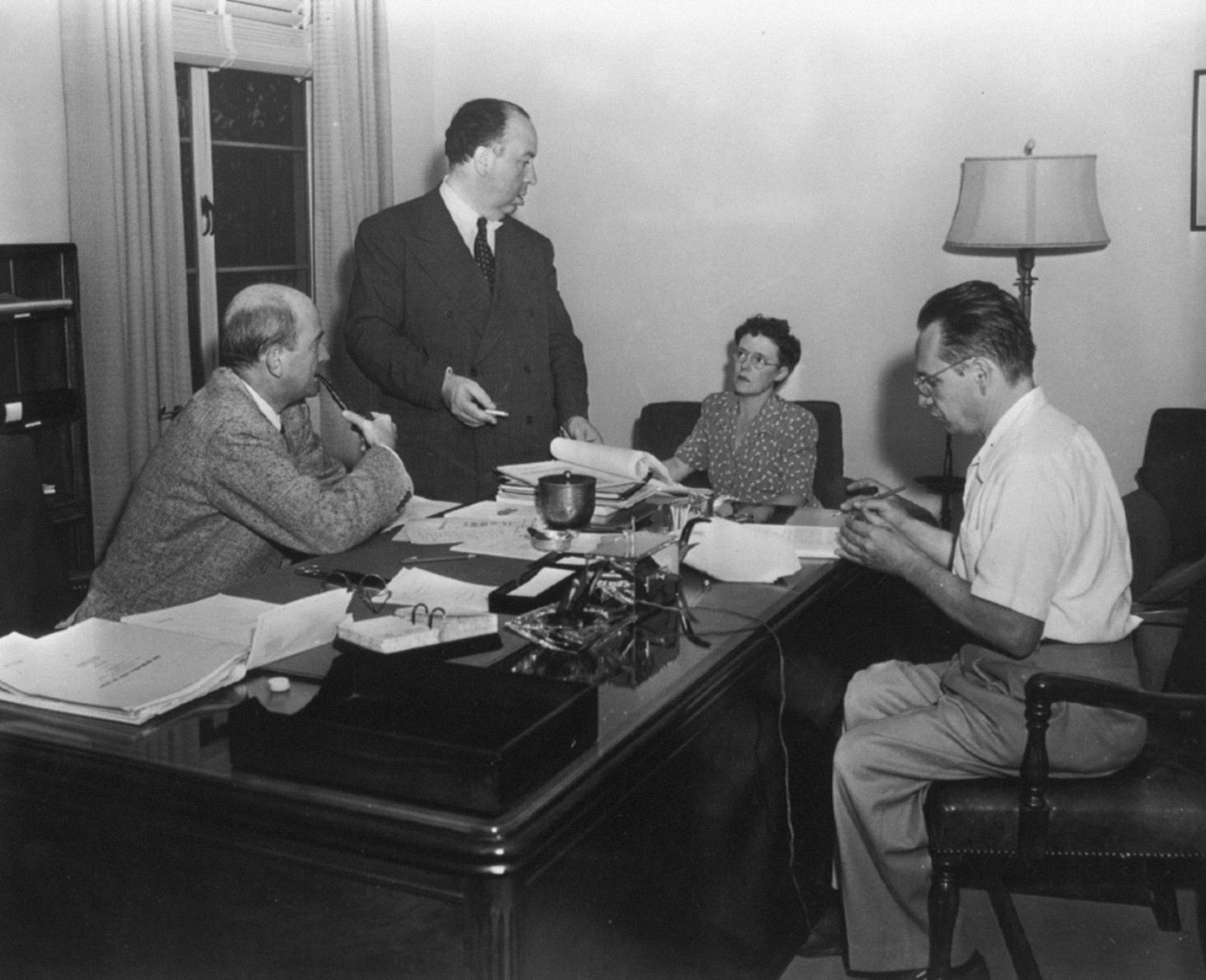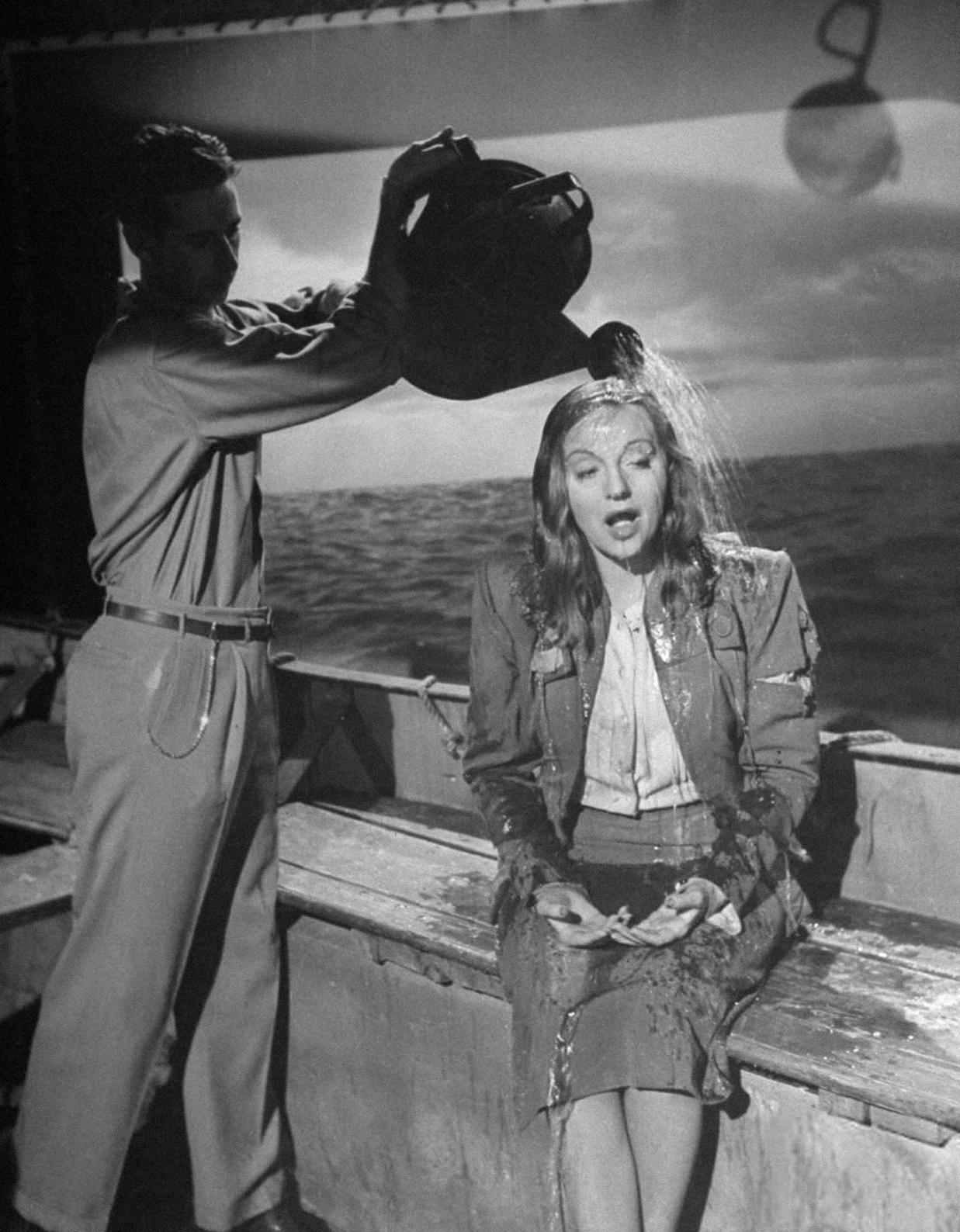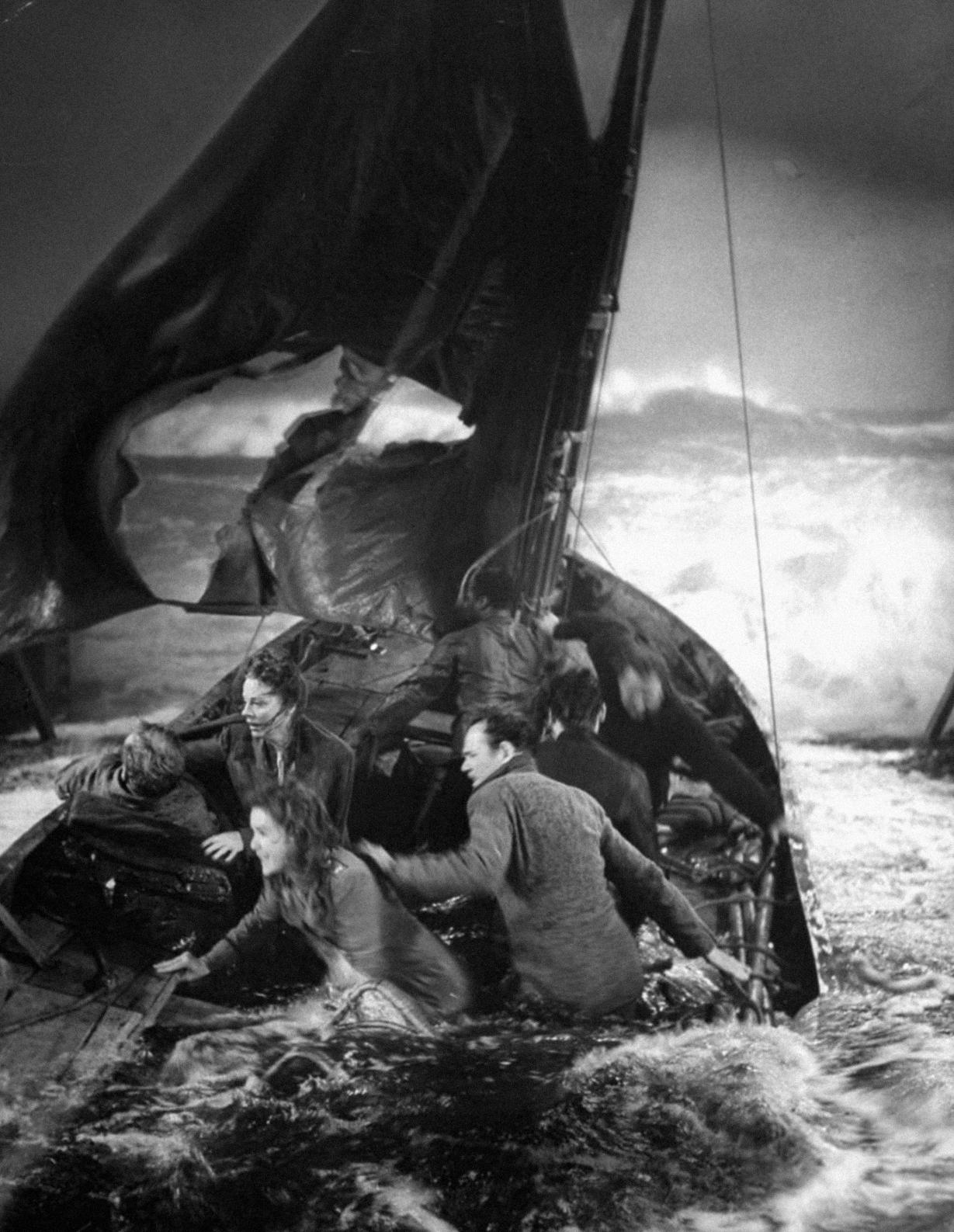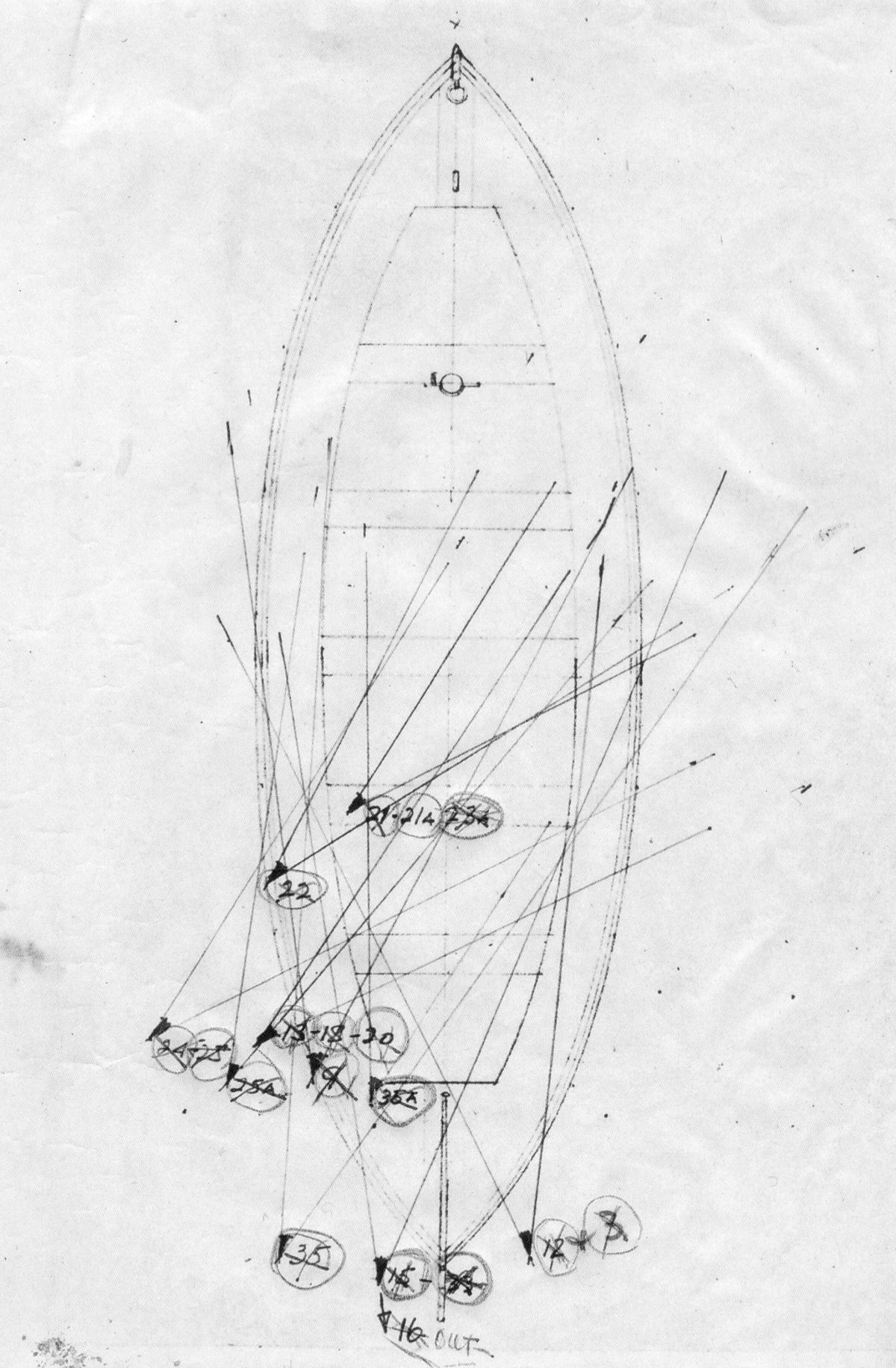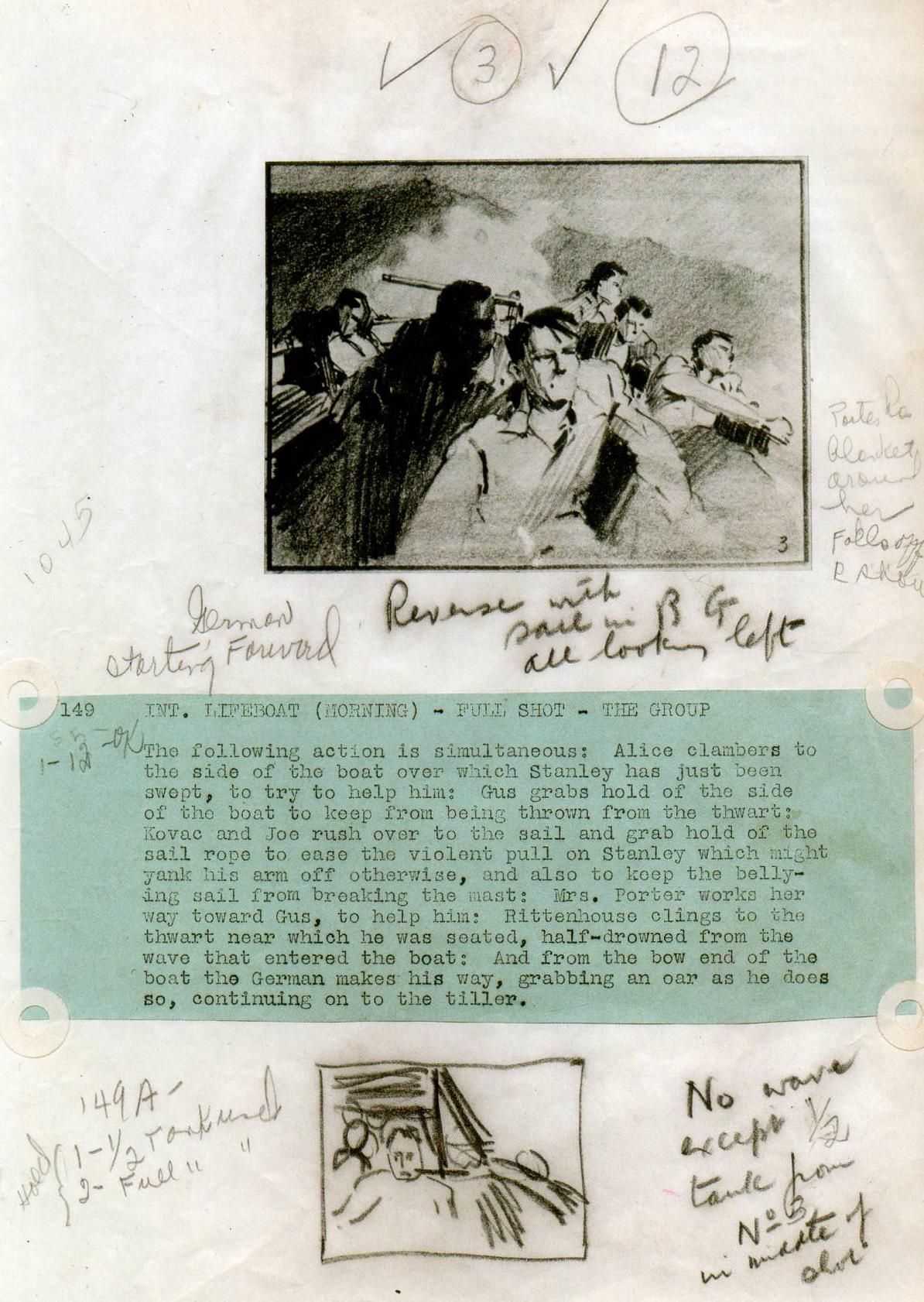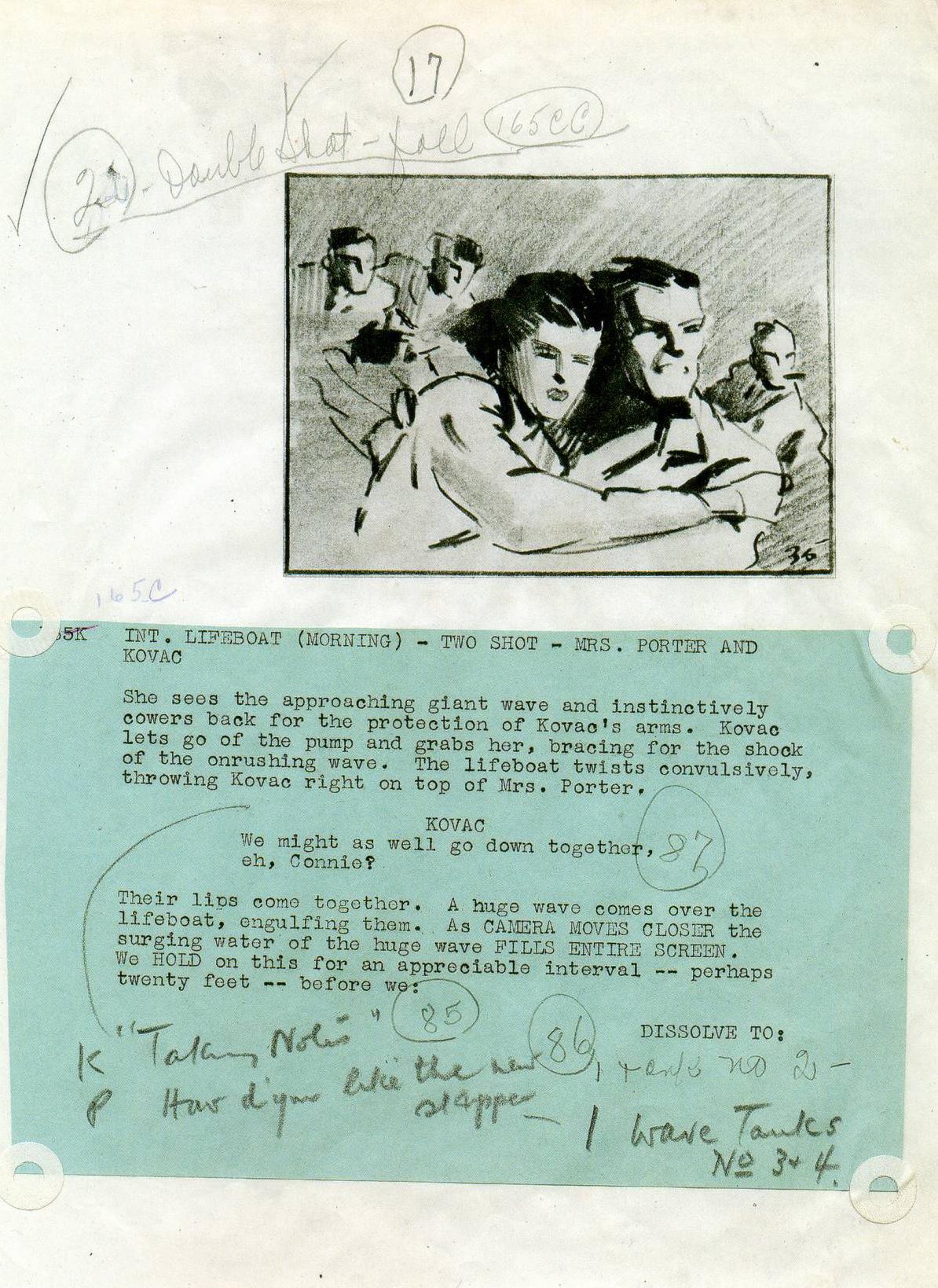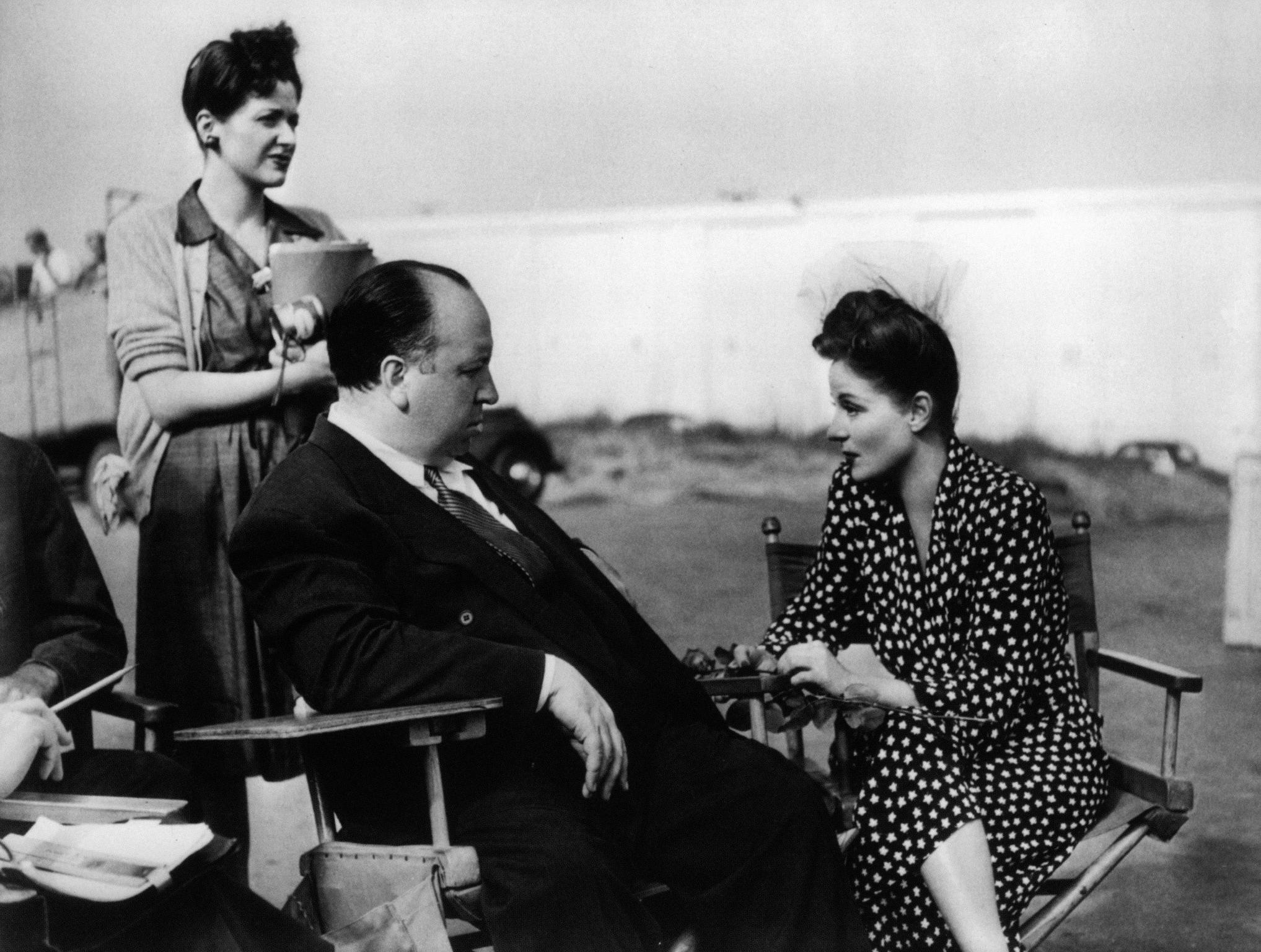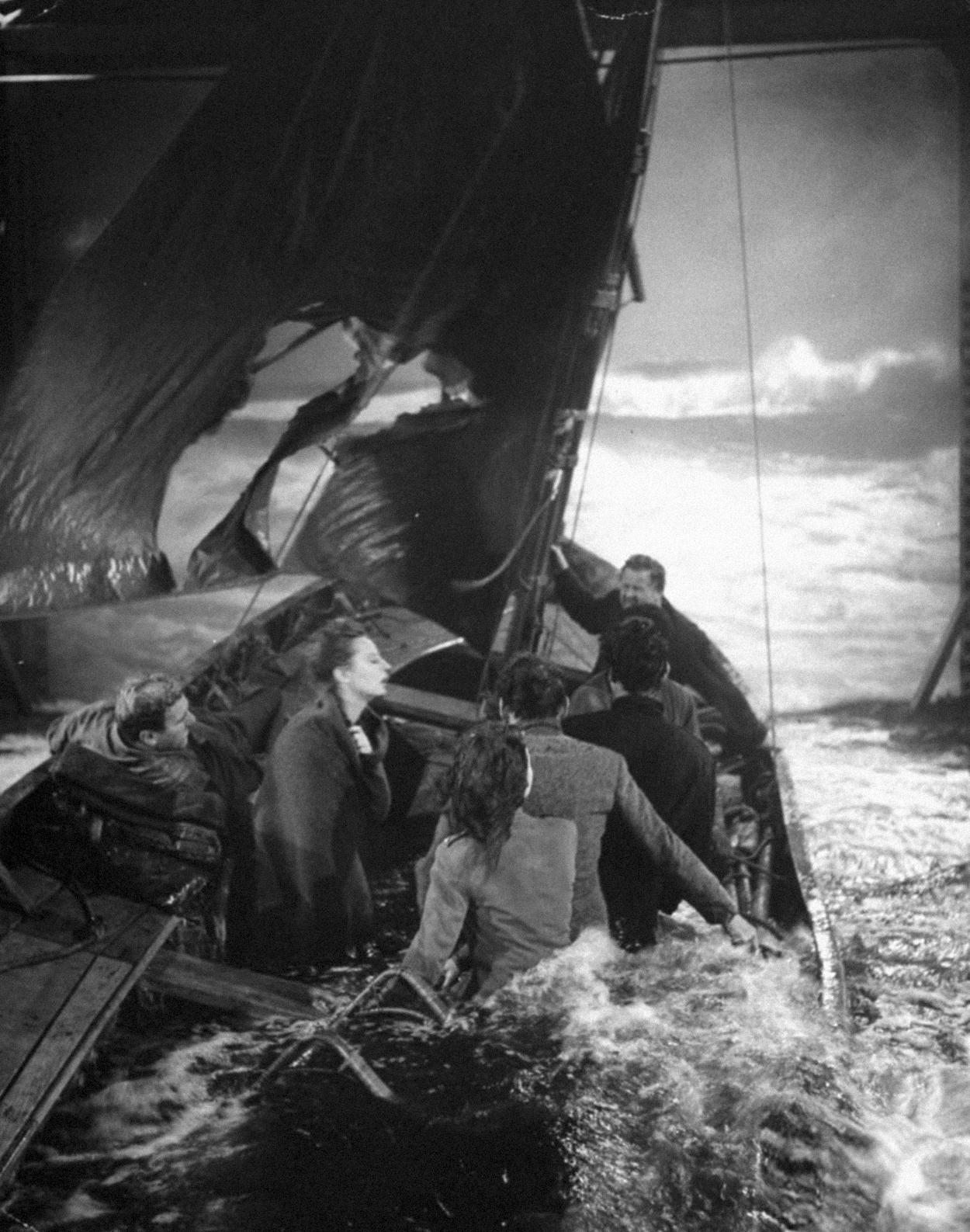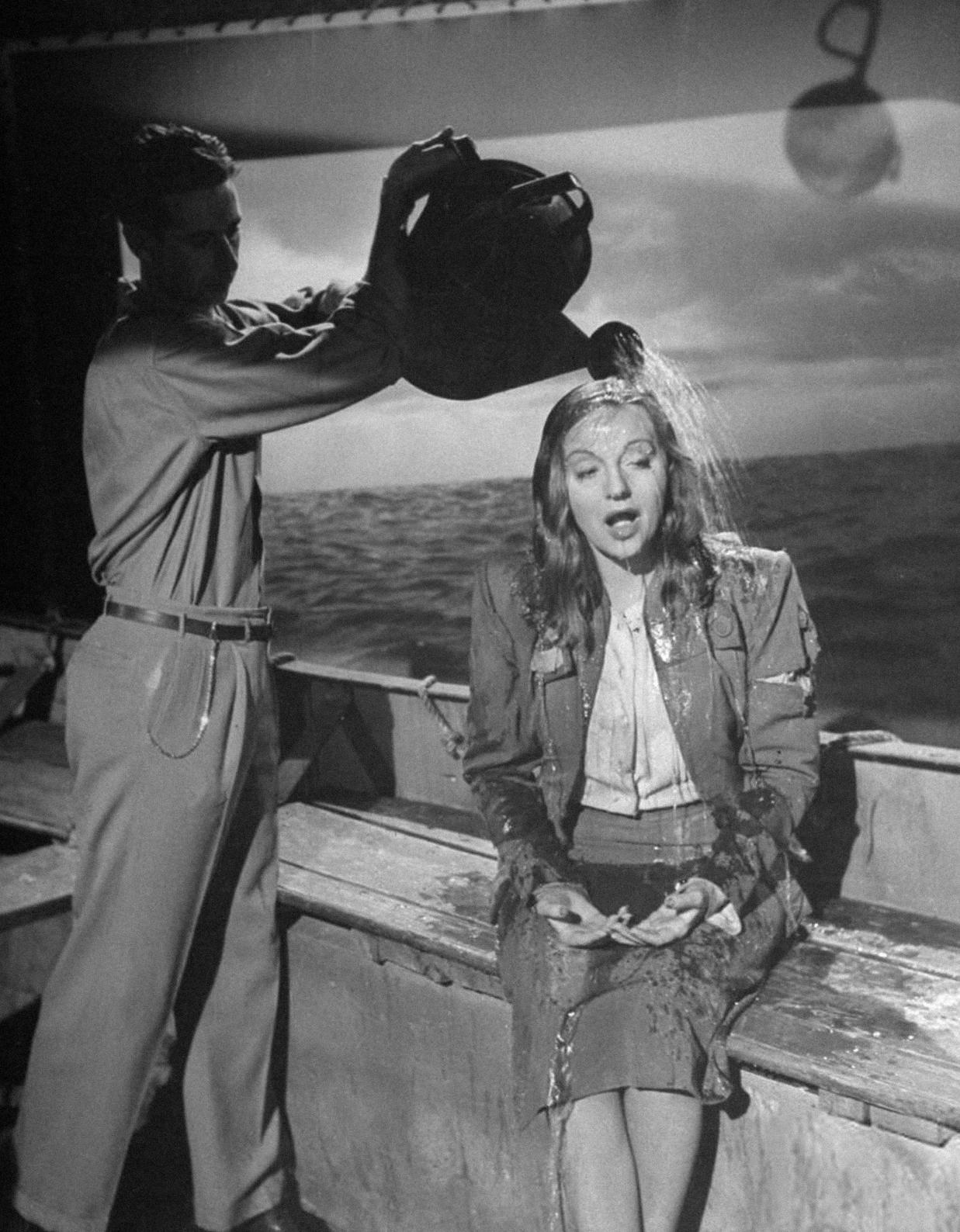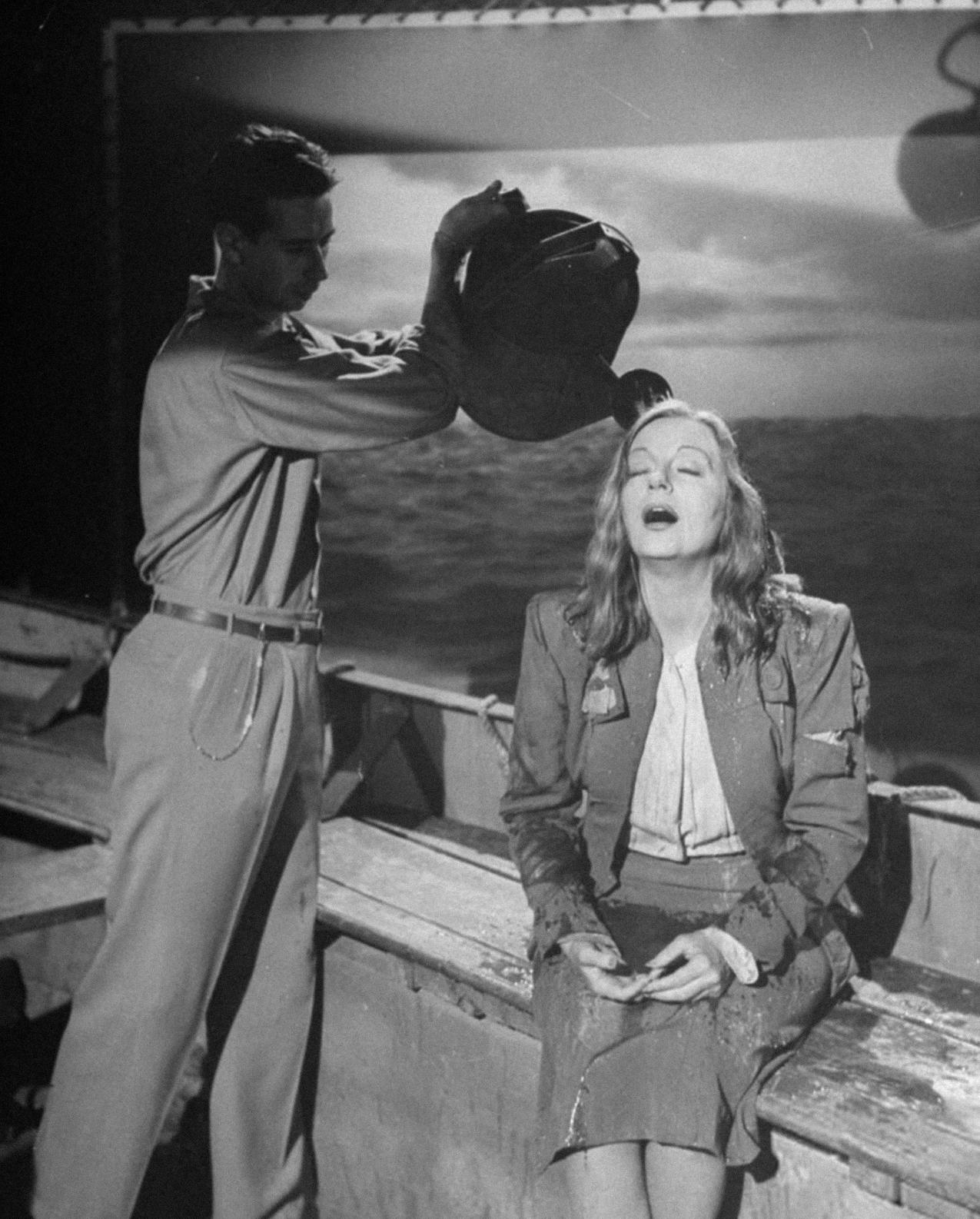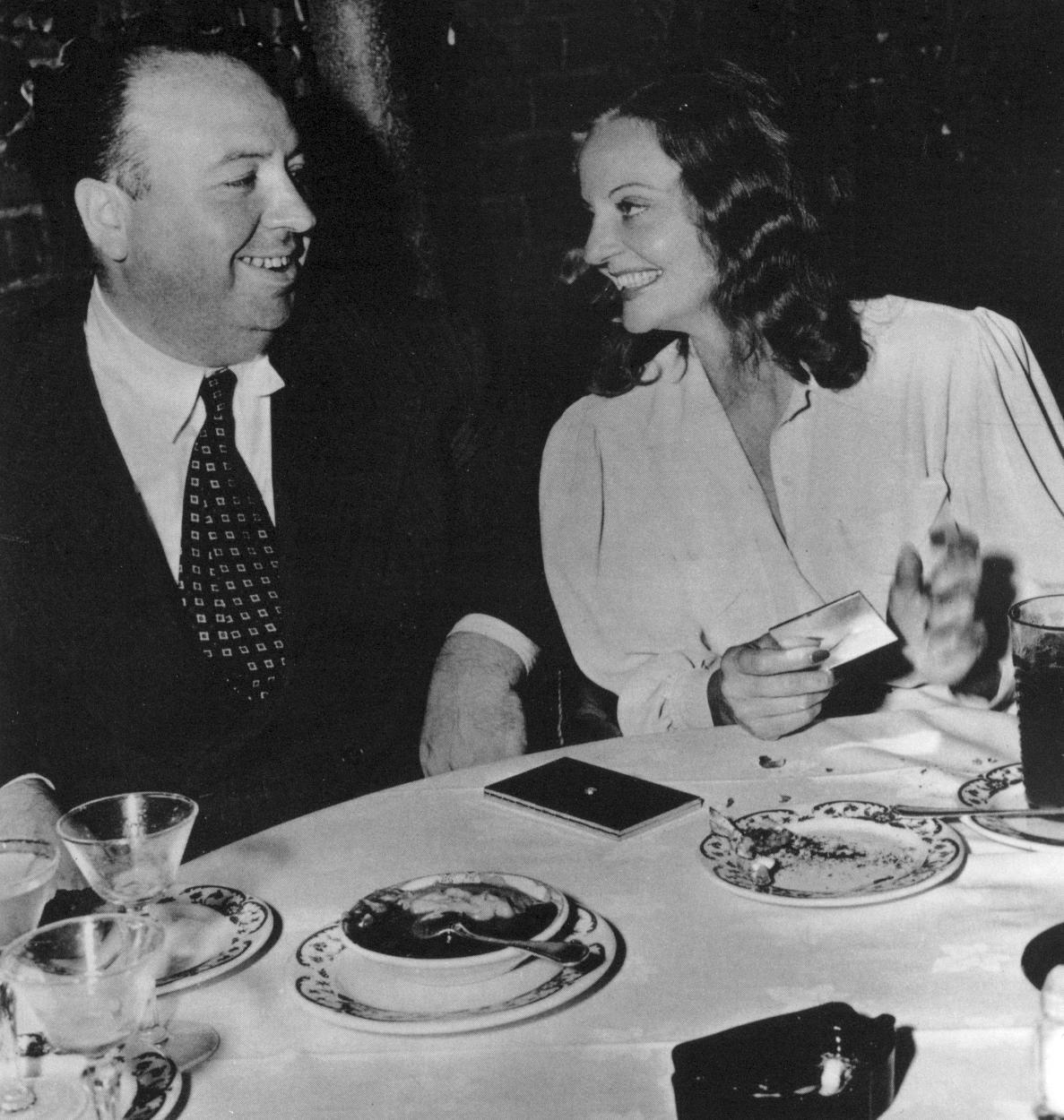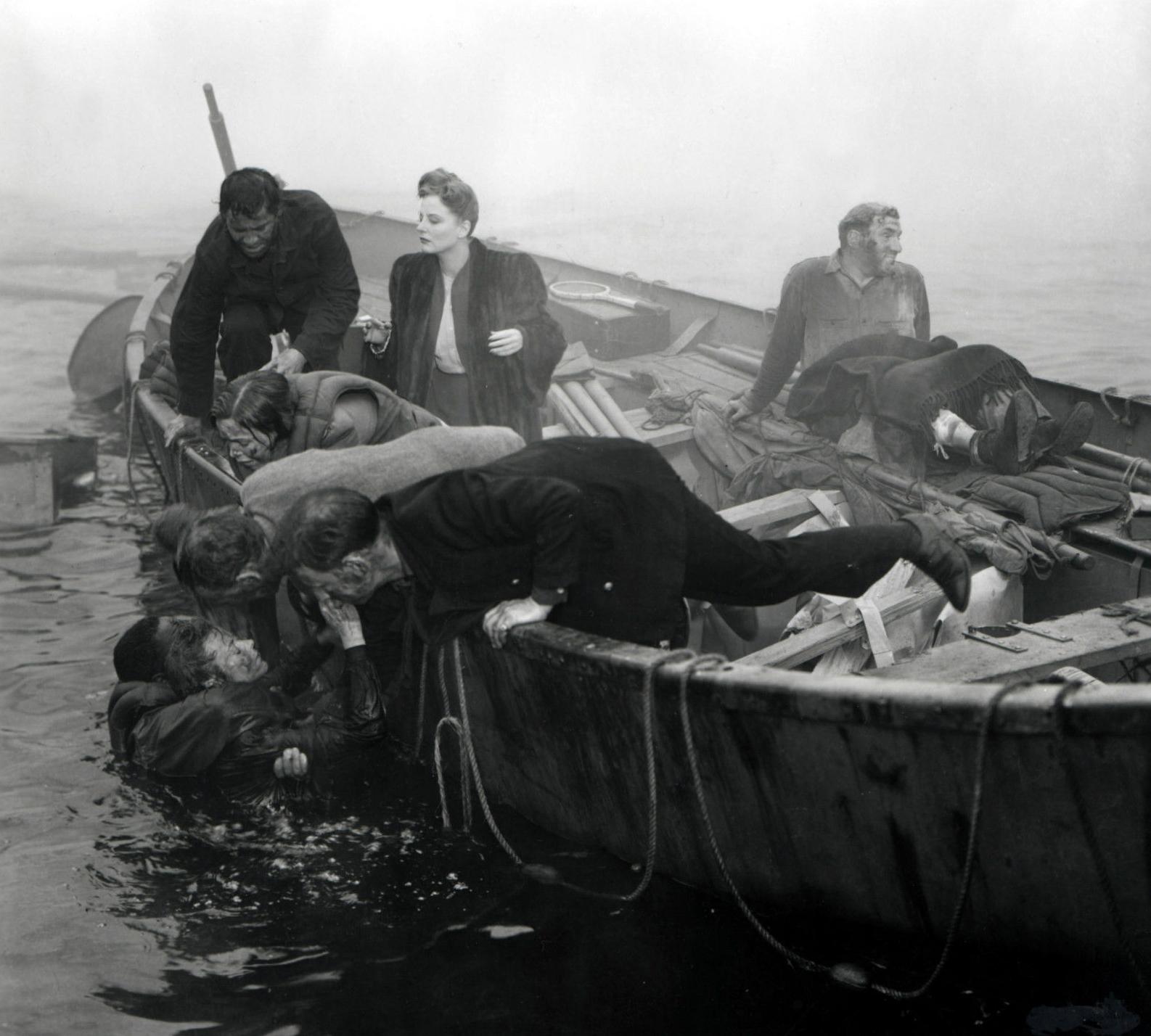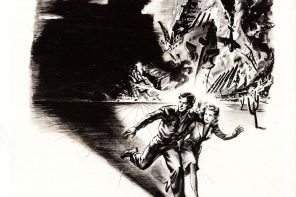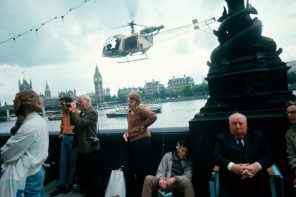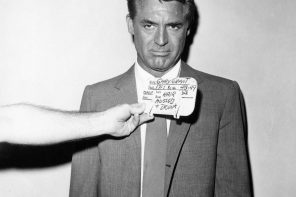By Sven Mikulec
The first in Alfred Hitchcock’s series of limited-setting films, the 1944 American drama thriller Lifeboat is a remarkable proof of the filmmaker’s expertise and power at creating tension stemming from different personalities stuck together in only a couple of square meters of space. A story of a handful of people inhabiting a lifeboat after a German submarine sinks the merchant ship they were on during the Second World War, Lifeboat is clearly an allegorical portrayal of the Allied forces and a cinematic expression of their need to unite, forget their differences and stop jumping on each other’s throats in order to defeat the hated enemy. The German side is represented by the captain of the Nazi submarine which caused all this turmoil, a guy called Willi whom the passengers save from the sea without knowing who he really is. It’s curious to note that, had Willi been depicted as a slightly less competent and intelligent man, Hitchcock’s film might have achieved better box office results.
The problem put forward by some influential film critics and political columnists at that time is that Lifeboat could be read as a piece of Nazi propaganda—why is the German character shown to be much more competent and determined than the desperate representatives of the United States and the UK? Discouraged by these remarks, 20th Century Fox allegedly held back with promoting the picture. Angered by the same comments, and further encouraged by the way Hitchcock and a whole gallery of screenwriters changed his screenplay, John Steinbeck requested his name be removed from the project. These accusations seem far-fetched these days, as it seems rather obvious that what Hitchcock and his screenwriting crew did with the story and its powerful German antagonist was create a simple and effective way of pointing to the historical fact that Germany took the world by surprise and punished the unprepared, passive, distrusting Western powers with careful planning and relentless execution.
The simple truth is that this specific work of art is a masterfully composed, spatially contained little thriller that not only offers some sublime acting and typically crafty direction, but also stands apart from the rest of Hitchcock’s corpus as something entirely different, innovative and original. Luckily enough, a lot of critics responded positively to it, even though it’s still maintained that Lifeboat didn’t quite get all the praise and recognition it deserved. Even if we remove the heavy, inescapable political context out of the picture, Lifeboat remains a very effective and skillful exploration of the human nature. As food rations dwindle and water supplies disappear, with no rescue ship in sight, all the masks are thrown overboard and we see human beings coming to terms with the immediate reality of pain and death.
Starring Tallulah Bankhead, William Bendix, Walter Slezak and others, based on Hitchcock’s original idea and John Steinbeck’s subsequent novella, later worked on by screenwriter Jo Swerling, filmed in black-and-white by Glen MacWilliams and further distinguished by its utter lack of music except for the opening and closing credits, surgically precise and psychologically deep in its theme, Lifeboat is truly one of the highlights of Hitchcock’s career.
A monumentally important screenplay. Dear every screenwriter/filmmaker, read Jo Swerling’s screenplay for Lifeboat [PDF]. (NOTE: For educational and research purposes only). The DVD/Blu-ray (limited edition dual format Steelbook) of the film is available at Amazon and other online retailers. Absolutely our highest recommendation.
 Loading...
Loading...
HITCHCOCK/TRUFFAUT
In the fall of 1962, whilst The Birds was in post-production, François Truffaut carried out extensive interviews with Alfred Hitchcock at his offices at Universal Studios. The interviews were recorded to audio tape and the content eventually edited down into the ‘Hitchcock/Truffaut’ book. Buy ‘Hitchcock by François Truffaut’ from Amazon. Hitchcock/Truffaut documentary explores the art and influence of Hitchcock through his famed 1962 interview with François Truffaut. Available on HBO NOW and HBO GO.
With Lifeboat we come to the type of picture that represents a challenge. Wasn’t it pretty daring to undertake to shoot a whole film in a lifeboat?
That’s right, it was a challenge, but it was also because I wanted to prove a theory I had then. Analyzing the psychological pictures that were being turned out, it seemed to me that, visually, eighty per cent of the footage was shot in close-ups or semiclose shots. Most likely it wasn’t a conscious thing with most of the directors, but rather an instinctive need to come closer to the action. In a sense this treatment was an anticipation of what was to become the television technique.That’s an interesting point. At any rate, you’d always been intrigued by experiments with the unity of space, time, or action. Still, another interesting aspect is that Lifeboat is the very opposite of a thriller; it’s a film of characterizations. Did the success of Shadow of a Doubt have anything to do with your choice of this subject?
No, Shadow of a Doubt had no bearing on Lifeboat, which was solely concerned with the war. It was a microcosm of the war.At one time I was under the impression that Lifeboat intended to show that every one is guilty, that each of us has something to be ashamed of, and that your conclusion meant that no one man is qualified to pass judgment on others. But now I believe that I was mistaken in that interpretation.
You were indeed; the concept of the film is quite different. We wanted to show that at that moment there were two world forces confronting each other, the democracies and the Nazis, and while the democracies were completely disorganized, all of the Germans were clearly headed in the same direction. So here was a statement telling the democracies to put their differences aside temporarily and to gather their forces to concentrate on the common enemy, whose strength was precisely derived from a spirit of unity and of determination.It was quite convincing.
The seaman, played by John Hodiak, was practically a Communist, and on the other extreme you had the businessman who was more or less a Fascist. And in the great moments of indecision, no one, not even the Communist, knew just what to do. There was a lot of criticism. The famous columnist Dorothy Thompson gave the picture ten days to get out of town.The picture isn’t only psychological; it’s also frequently moral. Toward the end, for instance, when the people in the boat want to lynch the German, you show their backs huddled together from a distance. Wasn’t it your intent to create a repulsive vision of them?
Yes, they’re like a pack of dogs.So there’s a psychological conflict as well as a moral fable in this picture, with both elements well blended into the dramatic texture so that they never clash.
I had assigned John Steinbeck to the screenplay, but his treatment was incomplete and so I brought in MacKinlay Kantor, who worked on it for two weeks. I didn’t care for what he had written at all. He said, “Well, that’s the best I can do.” I thanked him for his efforts and hired another writer, Jo Swerling, who had worked on several films for Frank Capra. When the screenplay was completed and I was ready to shoot, I discovered that the narrative was rather shapeless. So I went over it again, trying to give a dramatic form to each of the sequences.And you handled that by emphasizing inanimate objects, like Tallulah Bankhead’s typewriter, her jewelry, and so on?
Yes. One of the things that drew the fire of the American critics is that I had shown a German as being superior to the other characters. But at that time, 1940-41, the French had been defeated, and the llies were not doing too well. Moreover, the German, who at first claimed to be a simple sailor, was actually a submarine commander; therefore there was every reason for his being better qualified than the others to take over the command of the life boat. But the critics apparently felt that a nasty Nazi couldn’t be a good sailor. Anyway, though it wasn’t a commercial hit elsewhere, the picture had a good run in New York, perhaps because the technical challenge was enormous. I never let that camera get outside the boat, and there was no music at all; it was very rigorous. Of course, the characterization by Tallulah Bankhead dominated the whole film.In a sense, she follows the same route as the heroine of The Birds, starting out as a jaded sophisticate and, in the course of her physical ordeal, gradually becoming more natural and humane. Her moral itinerary is punctuated by the discarding of purely material objects. It starts out with the typewriter that falls into the water and winds up with the gold brace let being used as fish bait when the survivors are starving. By the way, speaking of objects, I noticed that you used an old newspaper this time as a means of making your ritual appearance.
That’s my favorite role and I must admit that I had an awful time thinking it up. Usually I playa passer-by, but you can’t have a passer-by out on the ocean. I thought of being a dead body floating past the lifeboat, but I was afraid I’d sink. I couldn’t play one of the nine survivors, since each had to be played by a competent performer. Finally, I hit on a good idea. At the time, I was on a strenuous diet, painfully working my way from three hundred to two hundred pounds. So I decided to immortalize my loss and get my bit part by posing for “before” and “after” pictures. These photographs were used in a news paper ad for an imaginary drug, Reduco, and the viewers saw them-and me-when William Bendix opened an old newspaper we had put in the boat. The role was a great hit. I was literally submerged by letters from fat people who wanted to know where and how they could get Reduco.Did the critics’ harsh reaction to Lifeboat have a bearing on your decision to undertake two propaganda shorts for the British Ministry of Information in 1944?
Not at all! I felt the need to make a little contribution to the war effort, and I was both overweight and overage for military service. I knew that if I did nothing I’d regret it for the rest of my life; it was important for me to do something and also to get right into the atmosphere of war. Before that, I had discussed my next feature for Selznick; it was to be based on an English novel called ‘The House of Dr. Edwardes.’ Then I took off, but it wasn’t too easy to get to England in those days. I flew over in a bomber, sitting on the floor, and when we got halfway across the Atlantic, the plane had to turn back. I took another one two days later. In London my friend Sidney Bernstein was the head of the film section of the British Ministry of Information. It was at his request that I undertook two small films that were tributes to the work of the French Resistance.It seems to me that I saw one of them in Paris toward the end of 1944.
That’s quite possible because the idea was to show them in parts of France where the Germans were losing ground in order to help the French people appreciate the role of the Resistance. The first short was called Bon Voyage. It was a little story about an RAF man who is being escorted out of France through the Resistance channels. His escort was a Polish officer. When he arrives in London, the RAF man is interrogated by an officer of the Free French Forces, who informs him that his Polish escort was really a Gestapo man. Upon that startling revelation, we go through the journey across France all over again, but this time we show all sorts of details that the young RAF man hadn’t noticed at first, various indications of the Pole’s complicity with the Gestapo detail. At the end of the story there was a twist showing how the Polish officer had been trapped. At the same time, the RAF man learned that the young French girl who’d helped them, and had spotted the Pole as a spy, had been killed by him.Yes, that’s the one I saw.
It was a four-reel picture and the Free French forces supplied me with technical advisers. For instance, Claude Dauphin helped us with the dialogue. We used to work on the screenplay in my room at Claridge’s, and there was a whole group of French officers, including a certain Commander or Colonel Forestier who never agreed to anything the others suggested. We realized that the Free French were very divided against one another, and these inner conflicts became the subject of the next film, Aventure Malgache. One of the men there was an actor and a lawyer whose Resistance name was Clarousse. He was in his late sixties, but he had lots of energy and he was always at odds with his Free French companions who finally threw him in jail, in Tananarive. It was a true story and Clarousse told it himself. But when it was finished, there was some disagreement about it and I believe they decided not to release it.
CAMERA ANGLE SKETCH
Lifeboat is an exercise in close-ups and restricted space; while many films made extensive use of close-ups as a way of getting closer to the action, this style was also a precursor for the coming of television in the 1950s. The film, which features no musical score and was filmed entirely in a studio, required extensive pre-production for the design of its shots. The production utilized four lifeboats; one for rehearsals, one for the studio’s water tanks and two separate boats for close-ups and long shots. —Interiors
STORYBOARDS FOR ‘LIFEBOAT’
Storyboards for Alfred Hitchcock’s production of Lifeboat, 1944. Includes storyboards for opening sequence, scenes 148-165, scenes 289-318, and unnumbered sequences. Some pages are heavily annotated, with corresponding script pages taped below. Courtesy of the Margaret Herrick Library, Academy of Motion Picture Arts and Sciences.
THE MAKING OF ‘LIFEBOAT’
‘The Making of Lifeboat’ featurette offers movie snippets, archival materials and comments from Casper, Hitchcock’s daughter Pat and his granddaughter Mary Stone, and Library of America editor Robert DeMott. We get notes about World War II’s impact on Hitchcock and his career at the time, the genesis of the movie’s story, John Steinbeck’s involvement and the tale’s various iterations, casting, sets and storyboards, complications during the shoot, Hitchcock’s cameo, editing and Daryl F. Zanuck’s interference, and the film’s reception.
Here are several photos taken behind-the-scenes during production of Alfred Hitchcock’s Lifeboat © 20th Century Fox. Intended for editorial use only. All material for educational and noncommercial purposes only.
If you find Cinephilia & Beyond useful and inspiring, please consider making a small donation. Your generosity preserves film knowledge for future generations. To donate, please visit our donation page, or donate directly below:

